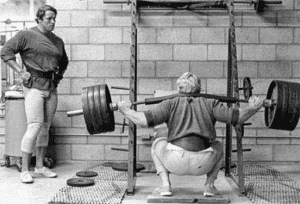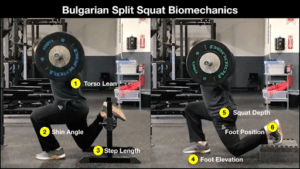Bilateral Limb Deficit Phenomenon
Bilateral Limb Deficit Blog
Conventional training during the off-season typically consists of tracking progress through 1RM during exercises such as squats, bench press, and deadlift. These are all considered double limb exercises for stability. However, conventional double limb training methods fail to express the specific movement patterns required of most field sports. Most movements associated with performance during field sports rely heavily on single limb activities These activities include: throwing, cutting, skating, and running. Meanwhile, conventional strength training typically utilizes a bilateral approach for maximal force production. Since most competitive team sports require high-powered single limb movements, it makes sense to include unilateral conditions in the training of our athletes.
Sum of the Parts is Greater Than the Whole
Aside from wisdom and conventional training, is there a better way to do things? Why wouldn’t you strive to improve the specificity of your training to mimic the conditions on the field? This will help to improve movement efficiency and translate to improved performance with a decreased risk of injury when on the field of competition.
There exists a phenomenon called the bilateral limb deficit, which further strengthens the argument to implement unilateral exercises. The bilateral limb deficit is known as the difference in maximal force production when comparing unilateral and bilateral loads. The sum of the unilateral force production of each limb is greater than the forces produced during the bilateral exercise.
Essentially, the bilateral limb deficit suggests that 1+1 > 2
 Single Leg Strength and Power
Single Leg Strength and Power
Maximal force production during bilateral exercises appears to be about 10% lower compared to unilateral exercises. It is most typically seen in dynamic lower body exercises. The average bilateral limb deficit during dynamic exercises was seen to be -11.7%. Upper body exercises saw a -5.8% deficit, compared to lower body exercises, which had a -13.2% deficit. The presence of the deficit is expressed to a greater degree as velocity of the exercise increases (-9% at 0 deg/sec vs. -49% at 424 deg/sec). This data suggests that we can achieve greater force production, which results in improved power, strength, and speed by utilizing unilateral exercises during our training. We can further improve force production by increasing the velocity of the exercise.
Stabilization
Increased stability demands of an exercise further exemplifies the expression of the bilateral limb deficit. This will result in improved motor unit recruitment to stimulate increased force production during a single limb exercise. This results in improved performance due to improved neuromuscular control for stability, and power due to increased muscular activation. Single limb exercise will help to decrease risk of injury due to the increase in stability demands. Increased stability demands will expose the tissues to variable movement patterns and improve their dynamic single limb balance. Single limb exercise also helps to eliminate limb-dominant neuromuscular patterns in patients who are at higher risk for ACL injuries.
Injury Prevention
Unilateral training allows for improved mobility, range of motion, proprioception, and stability. This will help to decrease your risk of injury by improving single limb stability, decrease compressive strain on the spine, improve strength, and enhance eccentric neuromuscular control. All of these factors will help to improve performance on the field during competitive field sports.
Strength Training and Performance Implications
Understanding that a bilateral limb deficit exists will help to shape how we choose to train our athletes. It is beneficial to utilize both double limb and single limb training, but not every athlete needs to be trained like a competitive powerlifter in order to increase their strength. Athletes may reach a plateau during a traditional back squat due to their limitations in core stability, but they still may not have reached the maximal strength capacity of their legs yet. Unilateral training will help to improve the strength of traditional bilateral exercises (squat, bench, deadlift), but bilateral training may not necessarily equate to increased unilateral strength. By understanding the bilateral limb deficit, it provides an opportunity to load them unilaterally, which will allow for greater isolated loading to each individual limb, while decreasing loads on the spine.
Single limb training will decrease limb-dominant movement patterns and help to improve dynamic balance. The addition of unilateral training to your program will improve your training based on the demands of the competition. This will help to decrease injury risk and improve performance.
Below is a basic example of how to interpret the data for Bilateral Limb Deficit:
- DL Squat 1RM = 300 lbs.
- Theoretical SL loads during DL Squat = 300/2 = 150 lbs.
- Actual SL RFESS 1RM = 165 lbs.
- Total Limb Load Capacity = 165 + 165 = 330 lbs.
- Load on each limb individually > load capacity on each limb during DL lift
o 165 lbs. load on targeted muscles and spine vs. 150 lbs. load on targeted muscles and 300 lbs. of load on spine
o 10% greater load capacity on working muscles with decreased compressive loads on spine
Try implementing some unilateral exercises into your training regimen and let us know what you think!
References
- Boyle M. Unilateral training and the bilateral limb deficit. 2016; https://www.strengthcoach.com/public/Unilateral-Training-and-the-Bilateral-Deficit.cfm
- Boyle M. Functional Training for Sports. Human Kinetics Publishers; 2016; 2: 109-110.
- Škarabot J, Cronin N, Strojnik V, Avela J. Bilateral deficit in maximal force production. Eur J Appl Physiol. 2016;116(11-12):2057-2084.


 Single Leg Strength and Power
Single Leg Strength and Power